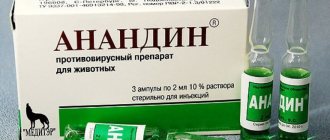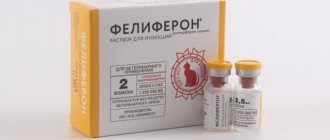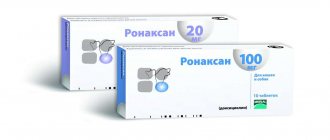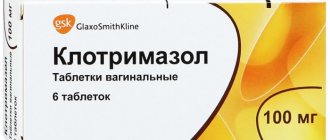Description of the drug Ciprovet
Ciprovet is a broad-spectrum veterinary drug that is used to treat diseases of bacterial origin. It is produced by the Russian organization NVC Agrovetzashchita LLC (Moscow region, Sergiev Posad), which specializes in medicines, vitamins and animal care products.
"Agrovetzashchita" is a research and development center that develops and produces veterinary drugs
The manufacturer of Tsiprolet has been developing unique formulas since 1993. The organization has more than 240 products, including antibiotics that are trusted not only by animal owners, but also by veterinarians.
Release form of the drug
Ciprovet is available in three dosage forms:
- Tablets (each 0.2 g). They are covered with a yellow shell and packaged in metallized blisters of 10 pieces. Each blister is packed in a separate cardboard box along with instructions for use.
- Eye drops. It is a transparent liquid without color or with a yellowish tint. The solution is packaged in polymer or glass bottles of 10 ml. Each bottle is packed in a cardboard box.
- Solution for injection 5%. A transparent, sterile, yellow liquid, packaged in brown glass bottles (10, 20, 50, 100 or 200 ml). Each bottle is sealed with a rubber stopper, which is rolled with an aluminum cap. There are cardboard boxes of 40 or 80 bottles, but most often you can find single packs.
The bottle of Ciprovet 5% is slightly different from the packaging of other dosage forms of the drug. Thus, the label of the bottle depicts several animals, because injections with this antibiotic can be prescribed not only to cats and dogs, but also to livestock. For poultry and cattle, there is another form of release of Tsiprovet - granules packaged in 1 kg.
An inexperienced cat owner may be inattentive in a hurry. So, in an emergency situation, you can lose your vigilance and buy a fake. Real Tsiprovet, regardless of the form of release, is marked with the manufacturer’s logo: a blue sign with the inscription “AVZ”.
Original drugs from Agrovetzaschita must have the organization’s logo
Photo gallery: Ciprovet preparations for cats
Ciprovet injection solution is intended for the treatment of more complex forms of bacterial infection
Ciprovet tablets are used in the treatment of bacterial diseases
Tsiprovet eye drops have anti-inflammatory and antibacterial properties
Table: composition of the drug
| Release form | Components | Content |
| Pills | Ciprofloxacin | 15 mg in 1 tablet |
| Eye drops | Ciprofloxacin | 0,45 % |
| Benzalkonium chloride | 0,05 % | |
| Trilon B | 0,08 % | |
| Water for injections | Up to 100% | |
| Injection | Ciprofloxacin | 50 mg/ml |
| succinic acid | 10 mg/ml | |
| Trilon B | 0.5 mg/ml | |
| Water for injections | Up to 1 ml |
Storage conditions for Tsiprovet
Tsiprovet should be stored in accordance with the manufacturer's recommendations: in a dry, dark place, away from food and cat food. It is most convenient to keep the drug together with other medications intended for pets, for example, in a medicine cabinet. The ideal storage temperature is between 5 and 25°C.
It is advisable for a cat owner to have a separate first aid kit for his pet.
Please note that the shelf life depends on the form of release of the drug:
- tablets - 4 years from the date of production;
- eye drops - 3 years (store an opened bottle for no more than 30 days);
- solution for injection - 2 years (opened bottle is valid for no more than 21 days).
What antimicrobial drugs are used in cats?
- Use of Trichopolum for cats
- Instructions for use of ceftriaxone for cats. Examine the breadth of the antibacterial effect of ceftriaxone in cats. Calculate the optimal dose of the drug. Improve therapy effectiveness by 200%
- Instructions for use of Metrogyl for cats. Explore the breadth of Metrogyl's antibacterial effects. Calculate the optimal dose of the drug for cats. Improve the effectiveness of therapy by 2 times
- Use of the antibiotic doxycycline in cats
- Instructions for use of clindamycin for cats (Clindamycinum). Study the breadth of the antibacterial effect of clindamycin in cats. Calculate the optimal dose of the drug. Improve therapy effectiveness by 140%
- Instructions for use of metronidazole for cats (Metronidazole). Study the breadth of the antibacterial effect of metronidazole in cats. Calculate the optimal dose of the drug. Improve therapy effectiveness by 140%
- Doxifin for cats (instructions for use, doses, indications and contraindications)
- Atovaquone for cats
- Azithromycin (Azithromycin) for cats (instructions for use, doses, indications and contraindications)
Indications for use of Tsiprovet
The active substance Ciprovet (ciprofloxacin hydrochloride) is an antibiotic of the fluoroquinolone group, so the drug is active against many types of bacteria:
- anthrax pathogen;
- causative agent of meningitis;
- Staphylococcus aureus (including antibiotic-resistant strains);
- saprophytic staphylococcus;
- streptococci;
- pasteurella;
- salmonella;
- Brucella;
- protea;
- Listeria monocytogenes;
- campylobacter;
- Pseudomonas aeruginosa;
- diphtheria bacillus.
Photo gallery: bacteria against which the drug is active
Diphtheria bacillus is the causative agent of a serious infection
Salmonella strain can cause typhoid, paratyphoid and other abdominal diseases
Staphylococcus is a bacillus that can cause many diseases of different organs and systems.
Streptococcus causes an infection that affects the respiratory and digestive systems
Indications for use of tablets
Ciprovet tablets are prescribed for the following diseases:
- infectious lesions of the respiratory and digestive systems;
- infections of the gallbladder and genitourinary system;
- bacterial lesions of the skin and mucous membranes;
- infectious diseases of the musculoskeletal system;
- secondary infections in viral diseases.
When are Ciprovet drops prescribed?
Ciprovet drops are prescribed for the following eye ailments:
- conjunctivitis (acute and chronic) and keratoconjunctivitis;
Most often, Tsiprovet drops are used in the treatment of conjunctivitis in cats.
- keratitis and blepharitis;
- corneal ulcers;
- septic iridocyclitis;
- foreign body getting into the eye;
- eye injuries.
Also, eye drops can be prescribed to prevent complications of previous ophthalmological operations.
In what cases are injections indicated?
Injections of the drug Ciprovet 5% are used for the following diseases:
- bacterial infections of the gastrointestinal tract and respiratory tract;
- diseases of the genitourinary system and mastitis-metritis-agalactia syndrome (puerperal fever);
- infectious diseases of the skin, soft tissues and joints;
- umbilical infections;
- atrophic rhinitis and bronchopneumonia;
Atrophic rhinitis in cats (when nasal discharge turns pinkish) requires treatment with antibiotics such as Ciprovet
- colibacillosis;
- pasteurellosis, salmonellosis;
- secondary infections of bacterial origin.
How the drug works
The active ingredient Tsiprovet destroys DNA in the nucleus of the pathogen cell, which leads to the death of the bacterium. Having been distributed in the tissues of the animal’s body, ciprofloxacin remains in a therapeutic dose for 24 hours. Excretion occurs primarily through urine and bile, and in lactating cats - through milk.
Ciprofloxacin destroys protein synthesis in the DNA of a bacterial cell
General information about ciprofloxacin
When treating diseases of cats and dogs, veterinarians do not always resort to antibiotics. Chemotherapy drugs of this group are prescribed in the following cases :
- Infectious lesions of the ears and eyes;
- Purulent lesions and skin infection;
- Treatment of diseases of a bacteriological nature (cystitis, piloeniphritis, pneumonia, pyometra and others);
- Diseases caused by various microorganisms - chlamydia and intestinal infections. Tuberculosis and leptospirosis, salmonellosis and pseudomonosis, staphylococcosis, enterococcal infection.
© shutterstock
Ciprofloxacin has a number of benefits. If used correctly and strictly following the dosage, the drug is slightly toxic. Treatment with an antibiotic will proceed faster. Even when used in the smallest dosages, it is effective.
Ciprofloxacin has a broad spectrum of antimicrobial activity. During the life of microorganisms that enter the animal, they release toxins that are poisonous to the body. The drug easily neutralizes and removes them. During the treatment process, the substance, entering the environment of microorganisms, does not lose its antibacterial properties.
There are some negative aspects to the use of Ciprofloxacin, which every cat owner should be aware of when treating the animal.
If you use this antibiotic whenever you want, without following the instructions, your pet’s body will get used to it and there will be no effect from the treatment. “Caring” owners begin to double the doses of the medicine, which can only lead to decomposition of the liver structure. Due to uncontrolled intake, the animal’s body will stop fighting even the slightest infectious inflammation.
© shutterstock
One of the most common side effects of any type of antibiotic is dysbacteriosis. In case of individual intolerance, anaphylactic shock may occur against the background of an allergic reaction.
The description of the drug Ciprofloxacin states that it should not be used by pregnant or lactating cats, small kittens, or animals with kidney disease . Veterinarians strongly do not recommend treating cats that are involved in breeding with this drug.
Very important : cats can only be given Ciprovet; they cannot be given the human drug Ciprofloxacin, since the second contains too much of the active ingredient.
Features of use in cats
The treatment regimen, drug form and dosage are prescribed by the veterinarian. Features of use depend on the purpose of using the antibiotic, as well as on the dosage form of Tsiprovet.
Most people I know make treatment decisions without consulting a veterinarian. This is usually done like this: the disease is determined by symptoms without tests, and then a medicine is selected. Treat the cat as advised on the forums. When it turns out that the medicine does not help, and the animal has become worse, the unfortunate owners go to the veterinary clinic, and their diagnosis is not confirmed. Of course, such sad results do not always happen, but it is not advisable to risk the life and health of your pet.
Use of tablets
Ciprovet tablets are used in cats once a day for 3–5 days. The dosage is selected based on the pet’s weight - 1 tablet per 3 kg of body weight. That is, if an animal weighs 4.5 kg, then it needs 1.5 tablets per day.
Video: how to give a pill to a cat
Features of using drops
Ciprovet eye drops are instilled into the affected eye, 1 drop at a time. The medicine should be used for 1 to 2 weeks, depending on the dynamics and complexity of the disease. If no improvement is observed after instillation, Tsiprovet can be replaced with another drug (usually veterinarians recommend changing the drops after 10 days of use if there is no positive dynamics).
If your cat's eyes are pus-filled or watery, but mucus is forming in the corners of the eyes, you will need to remove the discharge first. To do this, you need to drip 3-4 drops of Tsiprovet, remove all dirt with a sterile gauze cloth, and then drip a therapeutic dose - 1-2 drops.
Tsiprovet drops may cause a slight burning sensation (the cat will try to rub its eyes), you should not be afraid of this.
Video: how to drop medicine into a cat’s eyes
Tsiprovet injections
Ciprovet 5% is injected into the muscle or subcutaneously once a day for 3–5 days. The dosage depends on the cat’s body weight - 1 ml per 10 kg of weight.
It is difficult to divide a milliliter into several injections, so owners often exceed the recommended dosage. This is not critical, but the maximum daily dose of the solution should not be more than 1 ml.
It is not difficult to make a subcutaneous or intramuscular injection; for this you need to correctly determine the injection site. For subcutaneous administration, it is convenient to choose a place on the cat’s withers (the area between the back of the head and the shoulder blades). It is more convenient to give an intramuscular injection in the back of the hind limb (the fleshiest place on the leg). Here is a sample action plan:
- Draw the solution into the syringe without touching the needle.
- Release air bubbles from the syringe (a drop of medicine should appear at the tip of the needle).
- Secure the cat so that it cannot escape (you can ask household members to help).
- If the injection site is the withers, then you need to make a small fold with your thumb and forefinger.
- Insert the needle smoothly at an angle of 90 degrees to a depth of 1–1.5 cm.
- Introduce the drug without sudden movements (any movement of the needle in the tissues will cause pain).
- Pull out the needle and calm the animal.
- There is no need to rub the injection site.
The figure highlights the places that are most often used for injections.
Features of use in pregnant cats and kittens
It is not recommended to use Tsiprovet for the treatment of kittens, at least until the animal stops growing. It is believed that ciprofloxacin can affect the growth and development of a small organism, but veterinarians sometimes prescribe Ciprovet to kittens, for example, in the form of drops (if the threat to life is greater than the risk of negative consequences).
Ciprovet is also not recommended for pregnant cats. The antibiotic will definitely reach the future kittens, and this is dangerous for their lives. Ciprovet should not be given to nursing cats either.
Eye drops
The content of ciprofloxacin in eye drops is 0.45%. Also contains Trilon B, purified water and benzalkonium chloride. The medicine is produced in the form of a colorless or light yellow liquid, and is packaged in 10 ml polymer bottles. The bottles are easy to use, as they are equipped with a dropper pipette.
Note! After opening the bottle, the drops can only be used for 30 days.
Indications and contraindications
The instructions indicate that Ciprovet eye drops for cats are used for the following diseases:
- for conjunctivitis occurring in acute or chronic form;
- for blepharitis;
- for corneal ulcers;
- for keratitis;
- with septic iridocyclitis;
- with keratoconjunctivitis.
The drug can also be used to prevent the development of infectious pathologies in the following cases:
- after foreign objects get into the eye;
- after injuries of various types;
- after operations.
The medication should not be used for kittens under 7 days of age, or if they are intolerant to the components included in the composition. The drug has no other contraindications. If your pet has cerebral atherosclerosis, treatment with antibiotic eye drops should be carried out under the supervision of a doctor.
Features of application
Tsiprovet is instilled into the affected eye (or both) of cats, 1 drop. If the pathology is accompanied by purulent discharge, then the procedure is performed as follows:
- First, apply 3-4 drops.
- Gently wipe away the pus using a sterile gauze pad.
- Then reapply 1-2 drops.
You need to instill eye drops 3-4 times a day, and the course of treatment can be extended from 7 days to 2 weeks. If necessary, the course is repeated.
If Ciprovet is combined with other eye drops, a break of at least 5 minutes should be taken between instillations.
Interaction with other drugs
Ciprovet cannot be combined with the following antibiotics:
- chloramphenicol;
- tetracyclines;
- macrolides;
- theophylline;
- non-steroidal anti-inflammatory drugs;
- medications containing magnesium, calcium or aluminum cations.
Ciprovet should not be used in conjunction with bacteriostatic antibiotics.
Ciprovet drops cannot be combined with solutions with a pH level of 3–4, which are chemically or physically unstable. If, in addition to Ciprovet, other eye medications are prescribed, then they should be used at intervals of at least 5 minutes.
Tsiprovet can be combined with antiviral agents, immunomodulators and symptomatic medications:
- Suprastin;
- Kotervin;
- Gamavit;
- Milbemax;
- Fortiflora.
Photo gallery: drugs with which Ciprovet can be combined
Allergy medications (for example, Suprastin) can be used together with antibiotics. If we are talking about diseases of the genitourinary system, then Tsiprovet can be used together with diuretics, for example, Kotervin
Antibiotics are well compatible with immunomodulators and vitamin complexes, such as Gamavit
Tsiprovet can be combined with anthelmintics, which include Milbemax
Tsiprovet can be combined with probiotic preparations (one of them is Fortiflora)
What should I know about storing and disposing of this medicine?
Store Tsiprovet for cats in the container it was in, tightly closed and out of the reach of children. Store it at room temperature and away from excess heat and moisture (not in the bathroom).
It is important to keep all medications out of the reach of children as many boxes and bottles (eg, tablets, eye drop bottles) are not child resistant. Small children can open them easily. To protect young children from Ciprovet poisoning, always close the caps and immediately place the medicine in a safe place—one that is up or out of sight and reach.
Unneeded medications should be disposed of in a special manner to prevent pets, children, and other people from consuming them. Do not flush this medicine down the toilet.
Possible side effects and limitations
As a rule, there are no side effects after using Tsiprovet. Undesirable effects may occur if the cat is particularly sensitive to fluoroquinolones; the following symptoms will indicate this:
- loss of appetite, nausea, vomiting;
- swelling of the limbs or muzzle;
- lack of coordination in space;
- redness of the eyelids, itching or watery eyes - if we are talking about drops.
If such manifestations occur, the use of the antibiotic should be stopped. Symptoms of drug intolerance may resolve without any intervention. If the signs of allergy do not go away, you can contact your veterinarian (he may prescribe a desensitizing treatment that will reduce the body's sensitivity to this allergen). Contraindications depend on the dosage form of the drug.
Table: contraindications to the use of the drug
| Form of the drug | Contraindications |
| Pills |
|
| Eye drops |
|
| Ciprovet 5% |
|
How to use Ciprovet correctly
The duration of the therapeutic effect of Ciprovet tablets is about a day. The therapeutic effect of eye drops is shorter and usually does not exceed six hours.
Preparation and Precautions
Remember that Tsiprovet is toxic in any of its dosage forms. The use of the drug, its dose and treatment regimen must be agreed with a veterinarian, and when using Tsiprovet, safety measures must be strictly observed - ignoring them can cause harm not only to the cat, but also to its owner.
- Do not eat or drink water at the same time as giving your cat Ciprovet.
- Do not allow the medicine to come into direct contact with food and utensils, which you will then use for your needs.
- Dispose of used drug packaging immediately.
- Wash your hands thoroughly after treating your animal with Ciprovet.
- At the slightest manifestation of an allergic reaction, consult a doctor immediately.
It is better to give Ciprovet tablets to your cat on a full stomach - about half an hour after eating. Before dripping the eyes with the solution of the same name, they should be washed to remove purulent and other secretions - just gently wipe with a cotton pad slightly moistened in clean boiled water.
Before using Ciprovet drops, the cat’s eyes and the fur around them must be cleaned.
Dosage
It is not difficult to calculate the usual dosage of Ciprovet tablets, based on the weight of the animal: one tablet is required for three kilograms of weight. It is enough to give the medicine once a day. Eye drops, depending on the diagnosis, are performed three to four times a day; single dosage - one or two drops.
Duration of treatment
Oral use of Tsiprovet is most often prescribed for a short course - from three to five days, but the doctor may recommend longer treatment, based on the disease and the individual characteristics of your pet. The therapeutic course of treatment with eye instillation solution varies from one to two weeks.
If the drug does not help and the disease continues to progress, you need to stop taking Ciprovet and urgently consult a doctor for a new prescription.
How to put a solution in your eyes
Treatment of cat eyes with Tsiprovet is complicated by the fact that the use of these drops causes a short-term burning effect, which is poorly tolerated by emotional, pain-sensitive animals.
If your pet has a calm character, then it is enough to pet him before the procedure and lightly but securely fix his paws and muzzle so that eye drops are successful. It’s a completely different matter to have an obstinate or aggressive cat that is ready for any tricks just to prevent you from performing the necessary manipulation.
But even in this case, there is a simple and very effective way out. You need to lift the stubborn dog by the skin in the area of the withers - just like mother cats carry their little kittens from place to place. The reflex will work flawlessly - even the most disobedient animal will become pliable for a few minutes, and this time will be enough for you to complete the treatment procedure.
The bottle with Tsiprovet drops is very convenient to use
Tsiprovet is sold in convenient dropper bottles, so it can be instilled into the eyes very quickly and quite accurately. Before using the medicine, you should hold the lower and outer eyelid with two fingers and slightly separate them. After the required dose of the drug has reached the mucous membrane, it is recommended to massage the eyelids a little and immediately repeat these manipulations with the second eye.
If five to ten minutes after using Ciprovet drops the burning sensation has not gone away and the cat continues to show anxiety, you should show it to a doctor - perhaps your pet has an individual intolerance to the drug. However, this issue should be clarified in advance - the doctor will tell you how to test the medicine for the absence of an allergic reaction.
Video: putting drops in the cat’s eyes
How to give your cat pills
Holding the cat by the withers is very convenient to give her tablets . However, many owners adhere to a different “method” and simply swaddle their pet, like a small child, in thick fabric. An animal immobilized in this way cannot resist or scratch, and the owner will only have to open its mouth and feed it the pill.
Be sure to check whether the cat swallowed the tablet
This is not difficult to do, but certain skills are required. With your thumb and forefinger, you need to press on both sides the points where the upper and lower jaws connect - the cat’s mouth will open. The tablet should be placed deeper in the throat, at the root of the tongue, and then in one quick movement, run your hand from the chin down the animal’s neck. The cat will make an involuntary swallowing movement, and the tablet will go to its destination. But you still need to check to see if there is any medicine left in your pussy’s mouth.
Video: giving a cat a pill
Features of use in kittens and pregnant cats
Pregnant and lactating cats should not use Ciprovet tablets; This dosage form should not be used for small kittens and adolescents - the tablets are only suitable for adult, fully developed animals.
Kittens under seven days of age are not recommended to treat their eyes with Tsiprovet drops. But the use of this form is allowed during the cat’s pregnancy and feeding her babies.
Analogues of the drug Tsiprovet
The following antibacterial drugs are analogues of Tsiprovet:
- Dezacid;
- Ciprolet;
- Cipronate;
- Floximed;
- Tsiprinol (Ciprinol);
- Aziflumin;
- Ciprofloxacin (Ciproflorxacin).
When it comes to choosing a drug analogue, people usually simply choose a drug with a similar name (for example, antibacterial eye drops). When choosing an analogue, I try to read the composition - it is advisable to choose a product with the same active ingredient. If my trust in a medicine is caused by the reputation of the manufacturer, then I buy the drug of the same brand, albeit with a different composition (the main thing is that the antibiotic must have the same indications for use).
Photo gallery: similar drugs
Aziflumin is produced by the same manufacturer as Tsiprovet
Floximed contains the same active ingredient as Tsiprovet
Tsiprolet is the human analogue of Tsiprovet, it can be bought in a simple pharmacy
Ciprofloxacin is the closest analogue of Ciprovet
Tsiprinol is found on sale much less frequently than other analogues
Table: comparison of Tsiprovet analogues
| Analogue name | Developer | Active substance | Release form | Price |
| Tsiprolet | Dr Reddy, India | Ciprofloxacin | Pills | From 57 rubles for 10 pieces |
| Cypronate | Jerome Biotech, India | From 60 rubles for 10 pieces | ||
| Tsiprinol | KRKA dd, Slovenia | From 118 rubles for 10 pieces | ||
| Desacid | CJSC "Agroprom", Russia |
| Eye drops | From 182 rubles per bottle |
| Ciprofloxacin | CJSC "Update PFK", Russia | Ciprofloxacin | From 23 rubles per bottle | |
| Phloximed | World Medicine Ophthalmics, UK | From 240 rubles per bottle | ||
| Aziflumin | NVC Agrovetzashchita LLC, Russia |
| Injection | From 1300 rubles per 100 ml |











